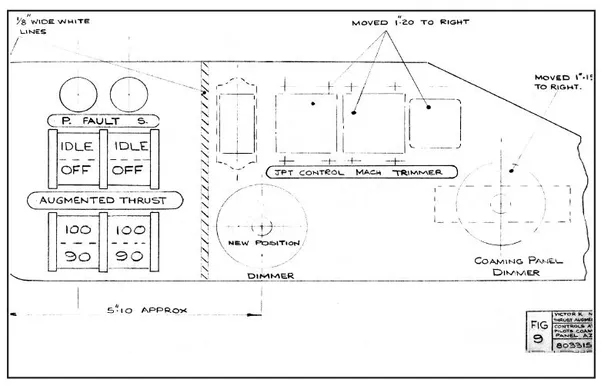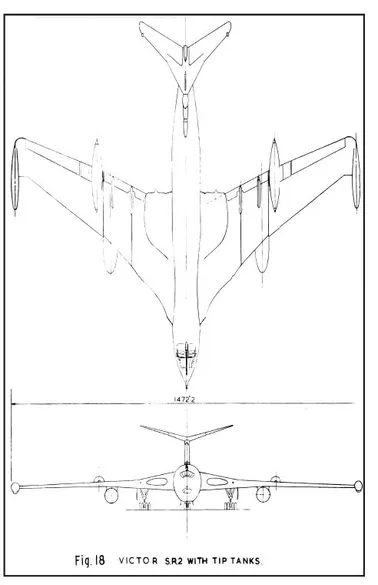Future Projects and Development Proposed By Handley Page 1965-1968
Thrust Augmentation Ref HP/PROJ/80377/EAN Issue 1 April 1966
At the end of October 1965 Handley Page was given the ITP Contract No KD/C/247/CB6(c) Item 1, to prepare a feasibility study on augmenting the engine thrust of the Victor Mk 1/1A tankers by an additional 7,000 to 8,000lb thrust. This study was to cover the following requirements at up to an ambient temperature of 30 deg C.
1. The various methods by which the thrust could be augmented
2. The degree of extra thrust by each method
3. The effect on improvement in the aircraft’s performance in terms of flight safety
4. Cost estimates
5. The embodiment time scales.
After a review of the practical methods in conjunction with Rolls Royce and Bristol Siddeley Engines three alternative proposals came to the forefront. These would involve two small jet engines housed in the wing-mounted pods similar to those as fitted to the Mk B2. These pods would have to be modified in a variety of ways to accommodate the needs of the engine and the servicing of it.
The engines being considered were:
• The Rolls Royce RB 162/81 combined with up-rating the Sapphire 20701 to 101.5 per cent in similar pods
• The Bristol Siddeley Orpheus 101 (Fitted to the Gnat) with up rating the Sapphire 20701 to 101.5 per cent in similar pods
• The Bristol Siddeley Viper 203 again in similar pods and combined with the uprating of the main engines together with the introduction of intake slots in the leading edge of the structure forward of each outboard engine.
• A review of liquid fuelled rockets HTP/AVTUR in the wing pods did not appear practical neither did solid propellant rockets.
Using these methods HP recommended that the total extra thrust would be 9,500lbs and therefore the aircraft’s all-up-weight should be 203,000lb to include 2,000lb for the two installations including fuel. The engines would be required to run for 10 mins at idle from start up and taxi to the runway. Then for 75 sees at take-off power and for 4 mins at 90 per cent power in the climb. The engines would be started by air tapped from the Sapphires and impinging on the turbine blades. Handley Page reviewed all the three main contenders and found two of the three feasible. One problem, however, was that the best engine, the Orpheus, was very heavy and this was a disadvantage. The usual fuel, fire protection, starting and instrumentation systems would be required. The controls would be situated on Panel AZ comprising a small group of illuminated push-button switches and warning lights occupying an area of 5 x 4 in located in the centre of the panel on the co-pilots side.
Drawing GA of Victor Tanker with Thrust Augmentation. HP-HPA
The development costs for this, including installation in Victor XA918, the CA Tanker, were £131,000 for the RB 162 or the Orpheus along with ground and flight testing to CA Clearance level. The Viper costs were in the region of £176,000.
Production costs for the fleet of twenty-four aircraft would be £1,222,000 for the RB 162/Orpheus and £1,291,000 for the Viper along with the cost of the engines which were estimated for 72 engines to be £2,000,000-£2,300,000 for the RB162, £1,870,000 for the Orpheus. The Viper was not quoted for but was in the region of £900,000.
Should this have gone ahead then the development time including Flight Testing and CA release was 22 months and it would take 9-10 weeks to install the modification into each aircraft along with the production test flights.
Drawing Thrust Augmentation Engine. HP-HPA
Controls for Thrust Augmentation. HP-HPA
Handley Page also suggested changing the engines on the Mk 1 to those of the Mk 2 the RR Conway with a new wing. This would cost £22,500,000 including the cost of 144 Conway Engines. Buying twenty-four KC135 with spares would cost £50,000,000. Converting twenty-four Victor Mk 2 to Tankers £7,000,000 and converting twenty-four Vulcan B2 to Tankers £7,000,000 + HSA costs of £2,000,000 and Flight Refuelling costs £1,000,000.
These figures were stated as very approximate and are given for comparisons purpose only.
Wing-tip Tanks Ref HP/PROJ/80379/AEP Issue 1 August 1966
In a letter from RAF B1 (b) dated 2nd September 1965 Handley Page were asked, following a request from the Air Staff, to reconsider a, earlier proposal for the fitment of tip-tanks to Victor aircraft in order to gain an improvement in wing-fatigue life.
An ITP was given in January 1966 under Contract KD/C/251/C.B.>63(a)
1 A report detailing the results of calculations of stresses in critical wing sections to demonstrate the effectiveness of the improvement in fatigue life due to the proposed installation in Victor B Mk 2 and SR and BK1 and BK1A and confirmation that there are no significant adverse effects. 2 (a). Initial design wing-tip tanks for Victor B and B/SR2 to the extent required fulfilling item 1.
2 (be). Initial ordering of long dated items in respect of 2(a) for Specimen and Trial Installation.
Drawing Underwing Tank and Tip Tank Installation. HP-HPA
Tip Tank, Thrust Augmentation and Mk 20B Pod. HP-HPA
3 (a). Initial design wing-tip tanks for Victor B/K1/K1A to the extent required fulfilling item 1.
3 (b). Initial ordering of long dated items in respect of 3(a) for Specimen and Trail Installation
4. Submission of considered cost estimates and details for: (a) Manufacture of Mod Kits for:
- (i) Mk 1 and Mk 2 Fatigue Test Specimen
- (ii) Mk 1 and Mk 2 Trail Installation
(b) Instrumentation, Ground and Flight Test on Mk 1 and Mk 2 aircraft
(c) Preliminary estimates for production -B/K1/K1A, B2 and SR aircraft-tooling, mod kits, installation costs.
A complete analysis has been made of the wing stresses on both Mks of aircraft. This shows an improvement factor of two on the fatigue life will be achieved when tip tanks are fitted. The optimum fuel capacity of these tanks is 350 gallons (2,800lbs) taxi trials using XA918 have shown the fatigue effects on the upper wing when taxiing, will still give an upper surface fatigue life in excess of the improved life of the lower surface when the tanks are fitted. Strengthening of the wing from station 480 outboard is required together with a modified wing-tip to mount the tank. No wing reinforcing is required inboard of this position either on the intermediate or centre wing.
At a wing fatigue meeting on 5/7/66 with the MOA, MOD and the RAE it was dec...






